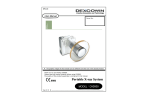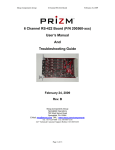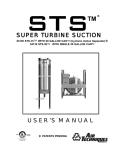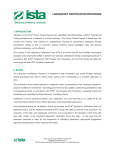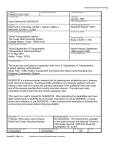Download Special Specification Template
Transcript
1993 Specifications CSJ 0914-33-036, Etc. SPECIAL SPECIFICATION 3442 Solar Power Assembly 1. Description. The purpose of this special specification is to describe the minimum acceptable requirements for the materials, equipment, and installation of a solar/battery powered assembly. The assembly shall be complete and include all components necessary for a fully functional installation including photovoltaic modules, batteries, solar generator assembly including the cabinet, battery vault, if required, and complete mounting assemblies. The batteries may be installed in a battery vault or cabinet as shown on the plans. All materials and construction methods shall conform to the details shown on the plans, the requirements of this special specification, and the pertinent requirements of the following Items: Item 618, “Conduit,” Item 620, “Electrical Conductors,” Item 624, Ground Boxes,” Item 656, “Foundations for Signs, Traffic Signals and Roadway Illumination Assemblies,” Item 680, “Installation of Highway Traffic Signals,” Item 684, “Traffic Signal Cables,” 2. Solar Generator. The system solar generator shall be sized to provide an array to load ratio of 1.1 or greater. The system average state of charge shall be 90% or greater throughout the entire year. The system loss of load probability shall remain 0% throughout the entire year. The system shall be designed and made available to handle the load of two 900 MHZ radios each operating at 12.0 VDC nominal load. A system sizing report shall be provided detailing the photovoltaic array, battery bank array to load ratio analysis, system availability analysis, battery state of charge report, battery depth of discharge (DOD), and monthly insolation information for the specified region. (1) Photovoltaic Modules. (a) The photovoltaic module shall provide 12 volts DC and shall be capable of recharging the system to full capacity, after 6 hours of continuous operation, in 3 hours ±0.5 hour during optimum sun conditions. The solar modules shall be industrial grade, polycrystalline type with a minimum 12 year warranty. Modules deemed to be of consumer grade will not be acceptable. Solar modules shall have a power output rating of ±5% or better. Electrical termination shall take place in a single, conduit capable, junction box. Solar modules should be available to TxDOT in a graduated product line from 40 to 120 watts per module. Each solar 1-5 3442 05-05 module, regardless of wattage size, shall share common mounting holes for mounting such that single mounting structure that will accommodate the entire module line. Each solar module shall incorporate 60 in. square polycrystalline cells and have at least 2 bypass diodes installed at the factory. Module construction shall utilize low iron tempered glass surface with an industrial grade anodized aluminum frame that completely surrounds and seals the module laminate. Construction should be consistent with the demands of installation near humid salt air environments. The mounting bracket shall have no less than four 3/4 in. stainless steel bolts, lock washers, and hex head nuts to secure the PV module to the frame. An ultraviolet (UV) resistant, weatherproof junction box providing wire termination for up to No. 8 AWG wiring shall be provided with the PV module. (b) The photovoltaic module mounting assembly shall be constructed of galvanized steel (ASTM A-153 Class A) or aluminum, of adequate design and strength to provide a means of securely attaching the PV module frame to a pole at a permanent angle of 45 to 50 deg. The pole mounting hardware shall accommodate poles ranging from a minimum four 1/2-in. outside diameter steel pole to a wood pole. The bracket shall be capable of 360 deg. horizontal orientation with a means of locking the bracket at an inscribed angular position about the pole. (c) The photovoltaic harness shall not exceed 2% total voltage drop between the solar module and the charge control circuit. (2) Battery. The batteries shall be group 27 gel batteries. The valve regulated, gelledelectrolyte batteries must be rated for a minimum of 2,000 cycles with 10% capacity withdraw. The batteries shall be 12 Volts D.C. nominal. The plate alloy shall consist of lead calcium. The element post shall be a T881 type terminal designed for ¼-in. bolt termination. The container/cover shall be polypropylene. The gelled electrolyte shall contain sulfuric acid, fumed silica, pure demineralized and deionized water, and a phosphoric acid additive. The gel cell battery shall be spill proof and should have the ability to be installed in any position. The batteries shall be sized to allow 12 days autonomy. DOD for the system shall not exceed 80%. 3. Control Cabinet. (1) The control cabinet shall be manufactured of sheet aluminum with a minimum thickness of 1/8 in., or cast aluminum alloy. The cabinet shall be sized to provide adequate space for the control electronics, radios, and desired number of batteries. The cabinets shall have louvers for ventilation and to prevent the accumulation of gasses. There shall also be rubber mats installed on the bottom of the cabinets and two 1/8-in. drain holes located in the bottom at opposite corners of the cabinet. The drain holes shall be covered with wire screen to prevent the entry of insects. The opening on the screen shall be no larger than 0.0125 sq. in. (2) The door and its opening shall encompass and constitute the entire area of the face of the cabinet. It shall be hinged via a continuous hinge which shall be riveted to the door and to the cabinet. The door shall be tightly secured via a latching device which pulls the door snugly against a neoprene gasket affixed to the cabinet body forming a 2-5 3442 05-05 weather-tight seal. The latching device shall be equipped with a standard police door locking device. (3) The cabinet shall be equipped with the necessary hardware to provide rigid top and bottom mountings to a pole with band on post hubs, or four 1/2-in. outside diameter pole clamps as shown on the plans. 4. Control Components. (1) The back panel shall be mounted on the inside of the cabinet. All electronic components within the cabinet shall be mounted to the back panel. The electronic components shall be easily installed or removed with simple hand tools. A 8 position double 8-32 x 5/16 in. binder head screw design terminal strip, with shorting bars, shall be located on the back panel. The following functions shall be available on the terminal strip: 1. 2. 3. 4. 5. 6. 7. 8. Solar Panel + Solar Panel - /BatteryBattery + Switch Common Switch N\O Output Circuit 1 Output Circuit 2 Output Common (2) The controller shall have an on-board, solid-state, charge control circuit to insure proper charging of the system battery bank. The charging circuit shall incorporate a blocking diode for reverse current protection. The charge control circuit shall incorporate thermal compensation to adjust the battery charge rate to variances in temperature with an adjustable voltage swing above and below the ambient set point as defined by the battery manufacturer. The battery float voltage calibration shall be at a voltage defined by the battery manufacturer at 77°F ambient temperature. A red LED/LCD shall be provided to indicate solar panel charging. (3) The controller shall contain a low voltage disconnect (LVD) circuit. This circuit shall disconnect the battery bank when the battery voltage reaches a voltage that is deemed critical by the manufacturer of the battery. The LVD shall be user adjustable. A red LED shall be provided and illuminated when the LVD circuit is active. (4) The unit shall be supplied with a color coded harness and a complete wiring diagram. Wires shall be a minimum 16 gauge stranded. Termination of the harness wiring to components mounted to the photovoltaic module, and radio shall be accomplished via connectors. Female connectors shall be terminated for ease of installation and male connectors are to be supplied with each harness. Battery terminals shall be 3/8-in. diameter round crimp terminals. Radio termination shall be spade terminals. Regulator/charger terminations shall be spade terminals. The harness shall be installed in the controller cabinet using chassis tie downs and riveted to the harness bracket. The harness shall have spiral tubing to protect wires from the control cabinet to the door. The total voltage drop of any branch of the harness shall be no greater than 5%. 3-5 3442 05-05 5. Spread-Spectrum Radio. The solar power assembly shall operate up to two 900 MHZ spread-spectrum radios as indicated on the plans. 6. Construction Methods. Solar powered assemblies shall be fabricated, assembled and installed in accordance with the plans and as recommended by the manufacturer. Erection of poles located near any overhead or underground utilities shall be accomplished using established industry and utility safety practices. The Contractor shall consult with the appropriate utility companys prior to beginning such work. Solar powered assemblies shall be located as shown on the plans, except the Engineer may shift the assemblies where necessary to secure a more desirable location. Unless otherwise shown on the plans, the Contractor shall stake and the Engineer will verify all solar powered assembly locations. Water-tight breakaway electrical disconnects shall be installed in all grounded conductors. Batteries installed in ground boxes shall come equipped with plastic covers that fit over the top of the battery. Plastic covers shall be placed over and secured to the batteries using approved straps. Ground boxes furnished to hold batteries shall be a battery vault ground box and shall be installed and equipped as detailed in the plans. 7. Warranty. Photovoltaic modules shall have a limited warranty for a minimum period of 12 years. The batteries shall have a 5 year prorated warranty. 8. Testing. Solar power assemblies shall meet or exceed all applicable NEC standards and this Special Specification. In addition to testing of preshipment samples, complete testing of solar power assemblies may be required at any time prior to acceptance. 9. Documentation Requirements. Each solar power assembly shall be provided with 2 each of the following documentation: (1) Complete accurate schematic diagrams. (2) Complete parts list including names of vendors for parts not identified by universal part numbers. (3) Full report on system analysis, to include all manufacturer's supporting documentation. (4) Complete user's manual for system. 10. Measurement. This Item will be measured as each solar-powered (photovoltaic) assembly complete in place including photovoltaic modules, batteries, power controller, cabinet, and complete mounting assemblies. 11. Payment. The work performed and materials furnished in accordance with this Item and measured as provided under “Measurement” will be paid for at the unit price bid for “Solar Power Assembly.” This price shall be full compensation for furnishing and installing each solar power assembly; and for all labor, tools, equipment and incidentals necessary to complete the work, except as shown below. New conduit will be paid for under Item 618, “Conduit.” New electrical conductors will be paid for under Item 620, “Electrical Conductors.” New ground boxes will be paid for under 4-5 3442 05-05 Item 624, “Ground Boxes.” New foundations will be paid for under Item 656, “Foundations for Signs, Traffic Signals and Roadway Illumination Assemblies.” 5-5 3442 05-05









